Page 1820 of 1943
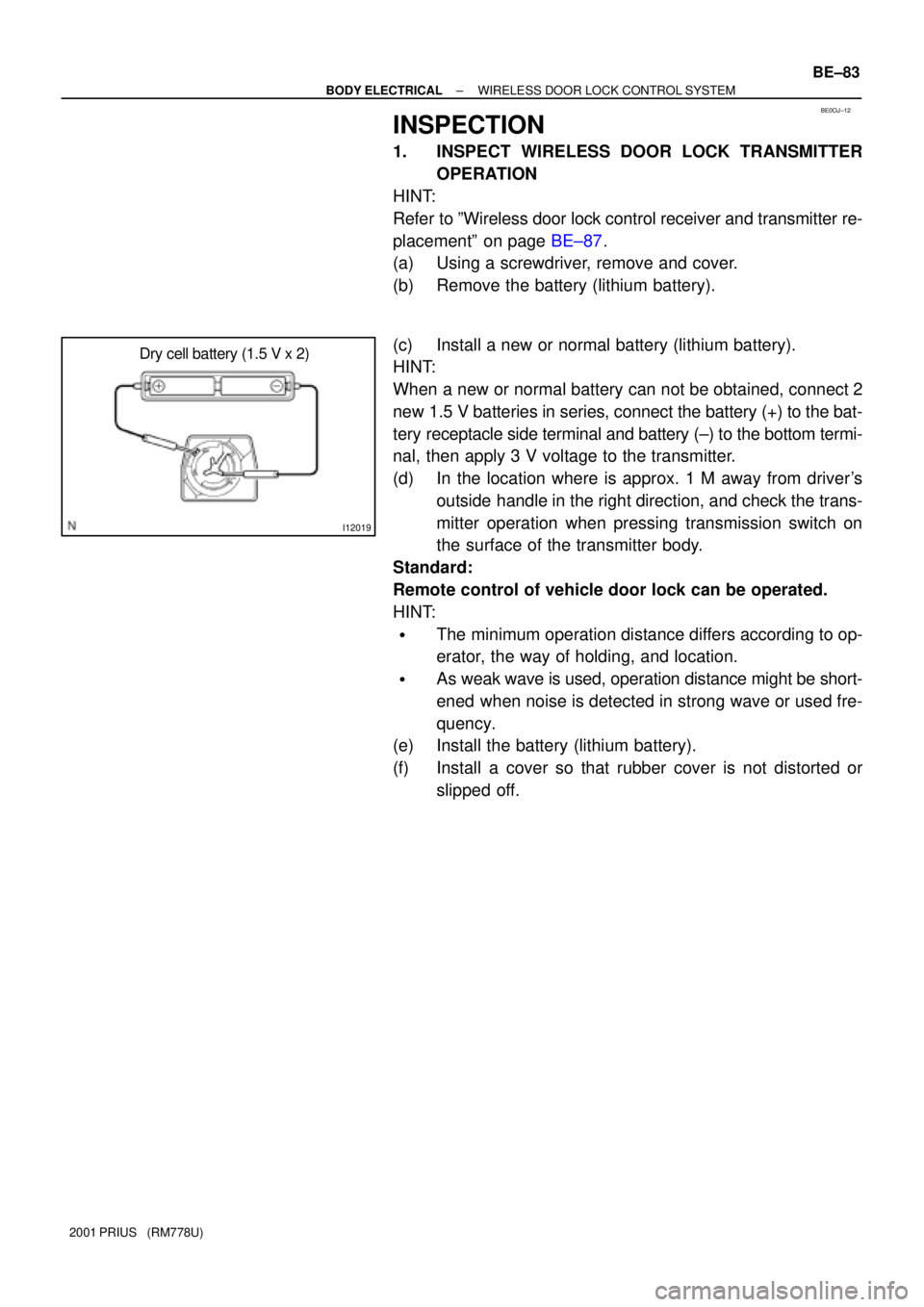
BE0OJ±12
I12019
Dry cell battery (1.5 V x 2)
± BODY ELECTRICALWIRELESS DOOR LOCK CONTROL SYSTEM
BE±83
2001 PRIUS (RM778U)
INSPECTION
1. INSPECT WIRELESS DOOR LOCK TRANSMITTER
OPERATION
HINT:
Refer to ºWireless door lock control receiver and transmitter re-
placementº on page BE±87.
(a) Using a screwdriver, remove and cover.
(b) Remove the battery (lithium battery).
(c) Install a new or normal battery (lithium battery).
HINT:
When a new or normal battery can not be obtained, connect 2
new 1.5 V batteries in series, connect the battery (+) to the bat-
tery receptacle side terminal and battery (±) to the bottom termi-
nal, then apply 3 V voltage to the transmitter.
(d) In the location where is approx. 1 M away from driver's
outside handle in the right direction, and check the trans-
mitter operation when pressing transmission switch on
the surface of the transmitter body.
Standard:
Remote control of vehicle door lock can be operated.
HINT:
�The minimum operation distance differs according to op-
erator, the way of holding, and location.
�As weak wave is used, operation distance might be short-
ened when noise is detected in strong wave or used fre-
quency.
(e) Install the battery (lithium battery).
(f) Install a cover so that rubber cover is not distorted or
slipped off.
Page 1821 of 1943
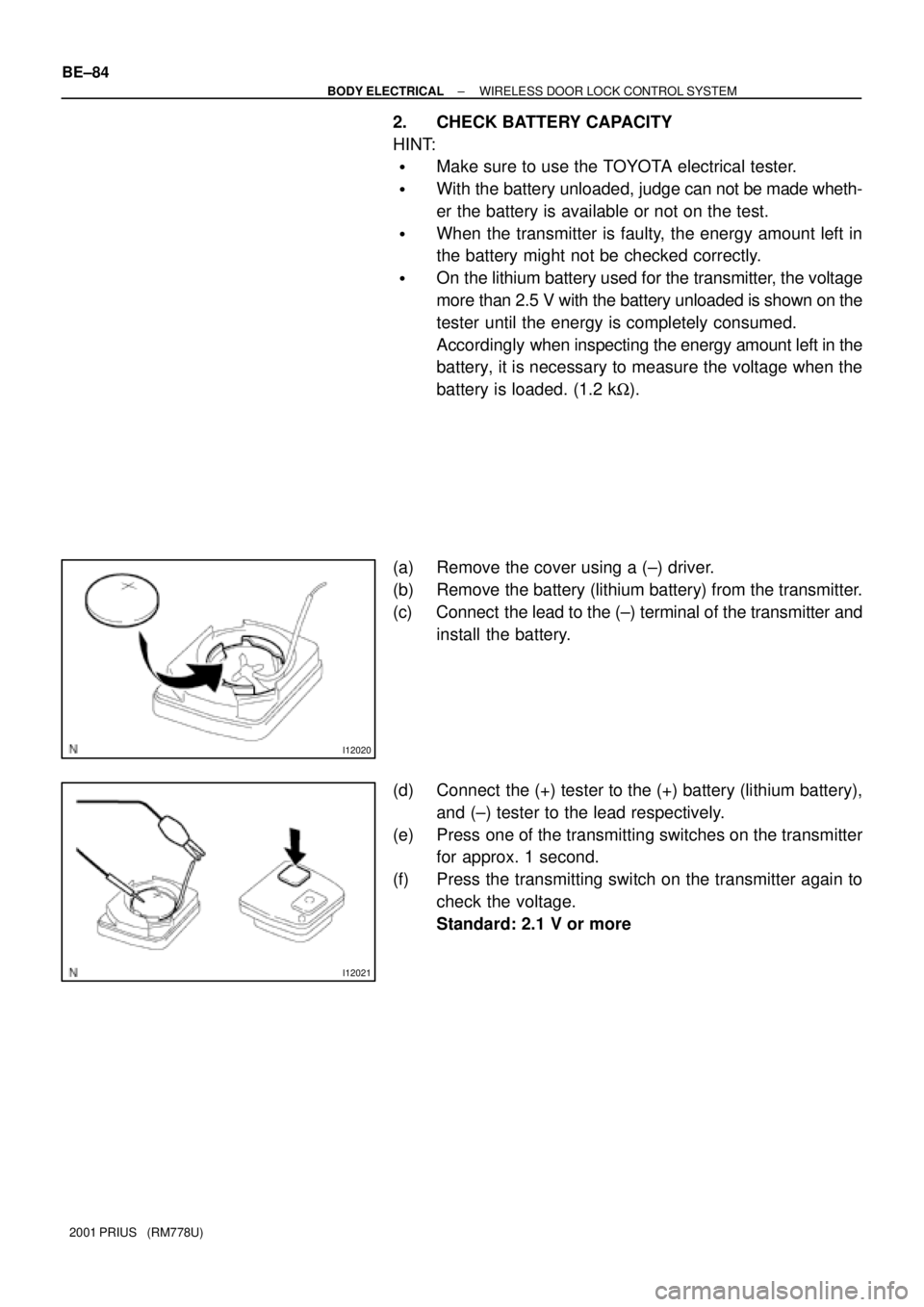
I12020
I12021
BE±84
± BODY ELECTRICALWIRELESS DOOR LOCK CONTROL SYSTEM
2001 PRIUS (RM778U)
2. CHECK BATTERY CAPACITY
HINT:
�Make sure to use the TOYOTA electrical tester.
�With the battery unloaded, judge can not be made wheth-
er the battery is available or not on the test.
�When the transmitter is faulty, the energy amount left in
the battery might not be checked correctly.
�On the lithium battery used for the transmitter, the voltage
more than 2.5 V with the battery unloaded is shown on the
tester until the energy is completely consumed.
Accordingly when inspecting the energy amount left in the
battery, it is necessary to measure the voltage when the
battery is loaded. (1.2 kW).
(a) Remove the cover using a (±) driver.
(b) Remove the battery (lithium battery) from the transmitter.
(c) Connect the lead to the (±) terminal of the transmitter and
install the battery.
(d) Connect the (+) tester to the (+) battery (lithium battery),
and (±) tester to the lead respectively.
(e) Press one of the transmitting switches on the transmitter
for approx. 1 second.
(f) Press the transmitting switch on the transmitter again to
check the voltage.
Standard: 2.1 V or more
Page 1822 of 1943
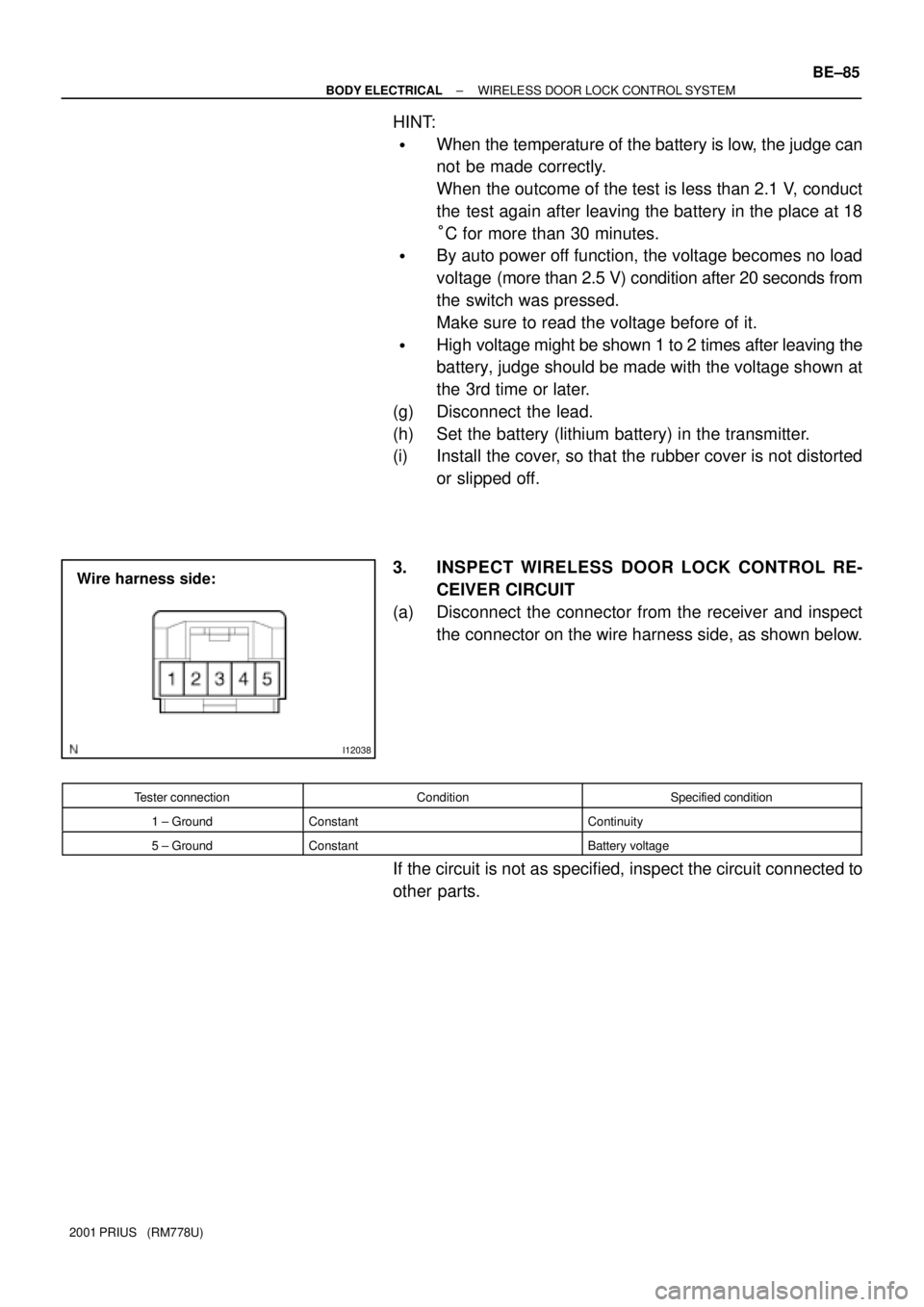
I12038
Wire harness side:
± BODY ELECTRICALWIRELESS DOOR LOCK CONTROL SYSTEM
BE±85
2001 PRIUS (RM778U)
HINT:
�When the temperature of the battery is low, the judge can
not be made correctly.
When the outcome of the test is less than 2.1 V, conduct
the test again after leaving the battery in the place at 18
°C for more than 30 minutes.
�By auto power off function, the voltage becomes no load
voltage (more than 2.5 V) condition after 20 seconds from
the switch was pressed.
Make sure to read the voltage before of it.
�High voltage might be shown 1 to 2 times after leaving the
battery, judge should be made with the voltage shown at
the 3rd time or later.
(g) Disconnect the lead.
(h) Set the battery (lithium battery) in the transmitter.
(i) Install the cover, so that the rubber cover is not distorted
or slipped off.
3. INSPECT WIRELESS DOOR LOCK CONTROL RE-
CEIVER CIRCUIT
(a) Disconnect the connector from the receiver and inspect
the connector on the wire harness side, as shown below.
Tester connectionConditionSpecified condition
1 ± GroundConstantContinuity
5 ± GroundConstantBattery voltage
If the circuit is not as specified, inspect the circuit connected to
other parts.
Page 1824 of 1943
BE1D9±02
N30017
N13468
± BODY ELECTRICALWIRELESS DOOR LOCK CONTROL SYSTEM
BE±87
2001 PRIUS (RM778U)
REPLACEMENT
1. REPLACE TRANSMITTER (LITHIUM) BATTERY
NOTICE:
Special caution should be taken for handling each compo-
nent as they are precision electronic components.
(a) Using a screwdriver, remove the cover.
NOTICE:
Do not pry out the cover forcibly.
HINT:
Push the cover with a finger as shown in the illustration, so that
there becomes clearance, then pry out the cover from that
clearance.
(b) Remove the transmitter.
(c) Remove the battery (lithium battery).
NOTICE:
�Do not push the terminals with a finger.
�If prying up the battery (lithium battery) forcibly to re-
move, the terminals are deformed.
(d) Install a battery (lithium battery) as shown in the illustra-
tion.
NOTICE:
Face the battery upward. Take care not to deform the termi-
nals.
(e) Check that the rubber is not distorted or slipped off, and
install the cover.
Page 1829 of 1943
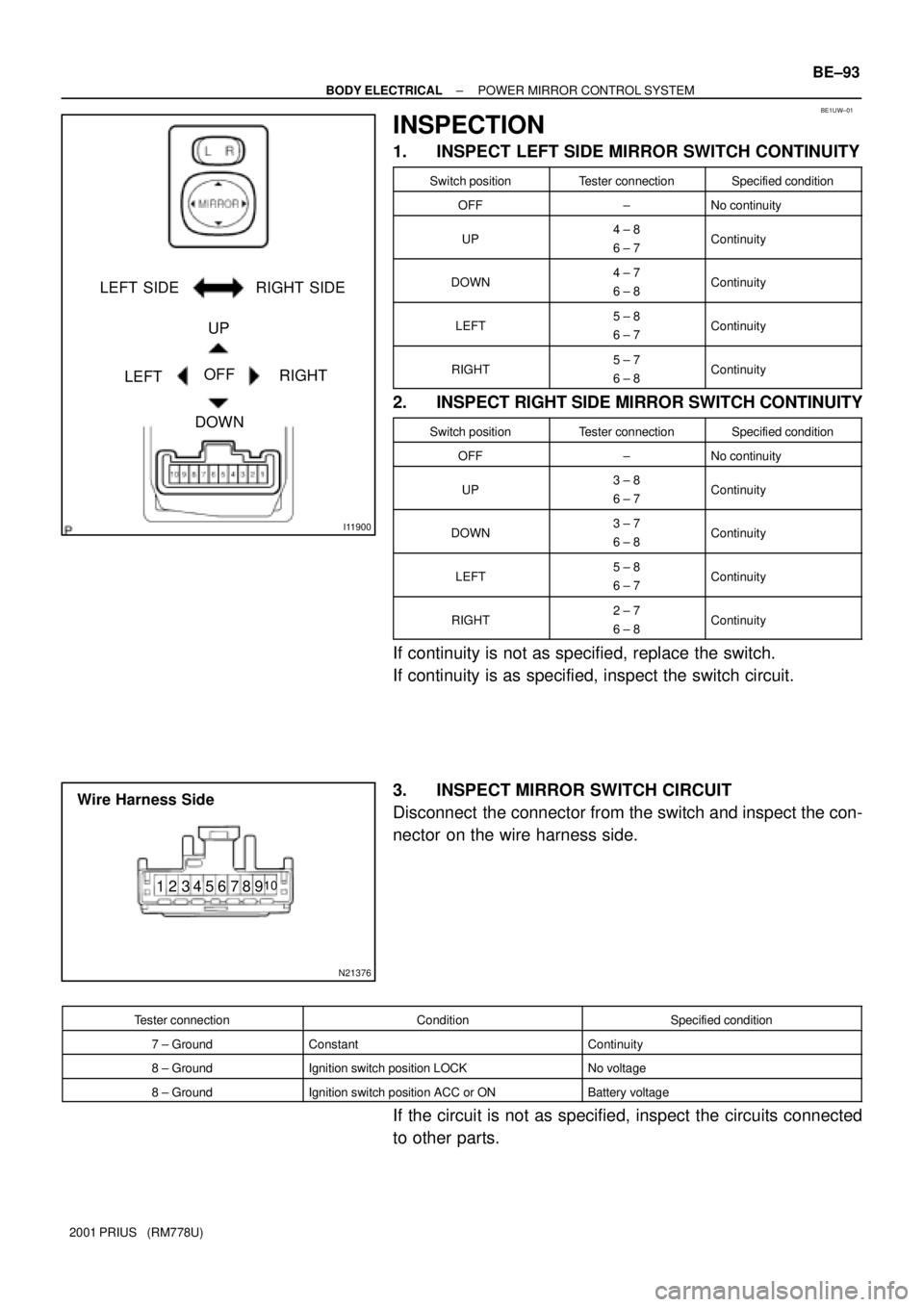
I11900
LEFT SIDE RIGHT SIDE
UP
LEFTRIGHT OFF
DOWN
BE1UW±01
N21376
12345678910
Wire Harness Side
± BODY ELECTRICALPOWER MIRROR CONTROL SYSTEM
BE±93
2001 PRIUS (RM778U)
INSPECTION
1. INSPECT LEFT SIDE MIRROR SWITCH CONTINUITY
Switch positionTester connectionSpecified condition
OFF±No continuity
UP4 ± 8
6 ± 7Continuity
DOWN4 ± 7
6 ± 8Continuity
LEFT5 ± 8
6 ± 7Continuity
RIGHT5 ± 7
6 ± 8Continuity
2. INSPECT RIGHT SIDE MIRROR SWITCH CONTINUITY
Switch positionTester connectionSpecified condition
OFF±No continuity
UP3 ± 8
6 ± 7Continuity
DOWN3 ± 7
6 ± 8Continuity
LEFT5 ± 8
6 ± 7Continuity
RIGHT2 ± 7
6 ± 8Continuity
If continuity is not as specified, replace the switch.
If continuity is as specified, inspect the switch circuit.
3. INSPECT MIRROR SWITCH CIRCUIT
Disconnect the connector from the switch and inspect the con-
nector on the wire harness side.
Tester connectionConditionSpecified condition
7 ± GroundConstantContinuity
8 ± GroundIgnition switch position LOCKNo voltage
8 ± GroundIgnition switch position ACC or ONBattery voltage
If the circuit is not as specified, inspect the circuits connected
to other parts.
Page 1830 of 1943
I01811
1
3
I01812
3 1
I01813
5 3
I01814
5
3
BE±94
± BODY ELECTRICALPOWER MIRROR CONTROL SYSTEM
2001 PRIUS (RM778U)
4. INSPECT MIRROR MOTOR OPERATION
(a) Connect the positive (+) lead from the battery to terminal
3 and the negative (±) lead to terminal 1, and check that
the mirror turns right side.
(b) Reverse the polarity, and check that the mirror turns left
side.
(c) Connect the positive (+) lead from the battery to terminal
3 and the negative (±) lead to terminal 5, and check that
the mirror turns to the downward.
(d) Reverse the polarity, and check that the mirror turns to the
upward.
If operation is not as specified, replace the mirror assembly.
Page 1835 of 1943
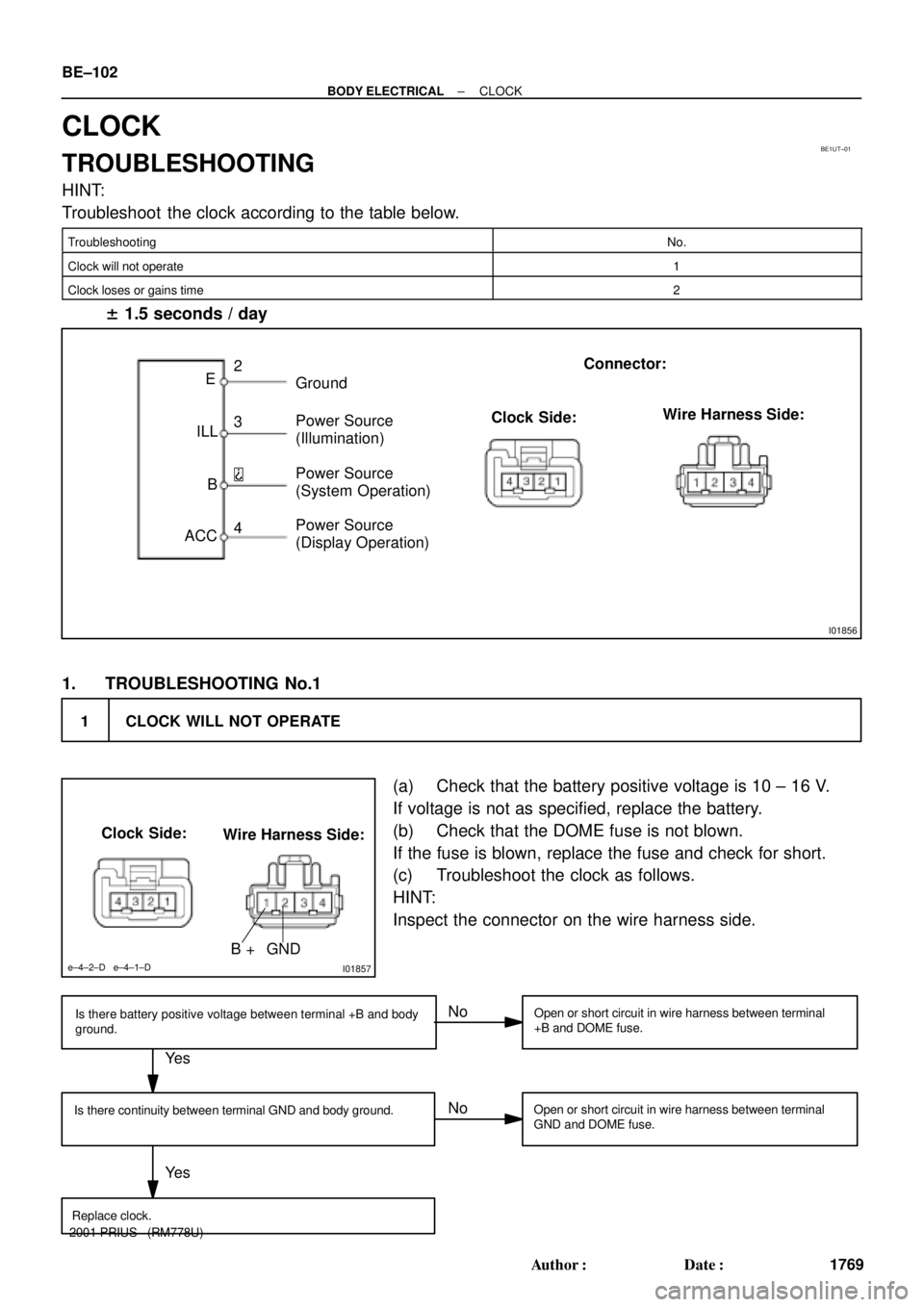
BE1UT±01
I01856
Ground
Power Source
(Illumination) E
ILL
B
ACCPower Source
(System Operation)
Power Source
(Display Operation)
2
3
4Connector:
Clock Side:Wire Harness Side:
1 CLOCK WILL NOT OPERATE
I01857
B + GND
e±4±2±D e±4±1±D
Clock Side:
Wire Harness Side:
Ye s
Ye sNo
No
Is there battery positive voltage between terminal +B and body
ground.
Is there continuity between terminal GND and body ground.
Replace clock.Open or short circuit in wire harness between terminal
+B and DOME fuse.
Open or short circuit in wire harness between terminal
GND and DOME fuse.
BE±102
± BODY ELECTRICALCLOCK
1769 Author�: Date�:
2001 PRIUS (RM778U)
CLOCK
TROUBLESHOOTING
HINT:
Troubleshoot the clock according to the table below.
TroubleshootingNo.
Clock will not operate1
Clock loses or gains time2
± 1.5 seconds / day
1. TROUBLESHOOTING No.1
(a) Check that the battery positive voltage is 10 ± 16 V.
If voltage is not as specified, replace the battery.
(b) Check that the DOME fuse is not blown.
If the fuse is blown, replace the fuse and check for short.
(c) Troubleshoot the clock as follows.
HINT:
Inspect the connector on the wire harness side.
Page 1836 of 1943
2 CLOCK LOSES OR GAINS TIME
I01858
Wire Harness SideClock Side
B+ GND
Ye s
Is there battery voltage between terminal +B and
body ground?
Adjust or replace clock.Bellow 10 V
Locate cause and repair, or recharge battery.
Ye s
Is there battery voltage between terminal ACC and
body ground?Bellow 10 V
Locate cause and repair, or recharge battery.
± BODY ELECTRICALCLOCK
BE±103
1770 Author�: Date�:
2001 PRIUS (RM778U)
2. TROUBLESHOOTING NO.2
(a) Check that the battery positive voltage is 10 ± 16 V.
If voltage is not as specified, replace the battery.
(b) Inspect the error of the clock.
Allowable error (per day): ± 1.5 seconds
If the error exceeds the allowable error, replace the clock.
(c) Check that the clock adjusting button is sticking in posi-
tion and has failed to return.
If the error exceeds the allowable error, replace the clock.
(d) Troubleshoot the clock as follows.
HINT:
Inspect the connector on the wire harness side.